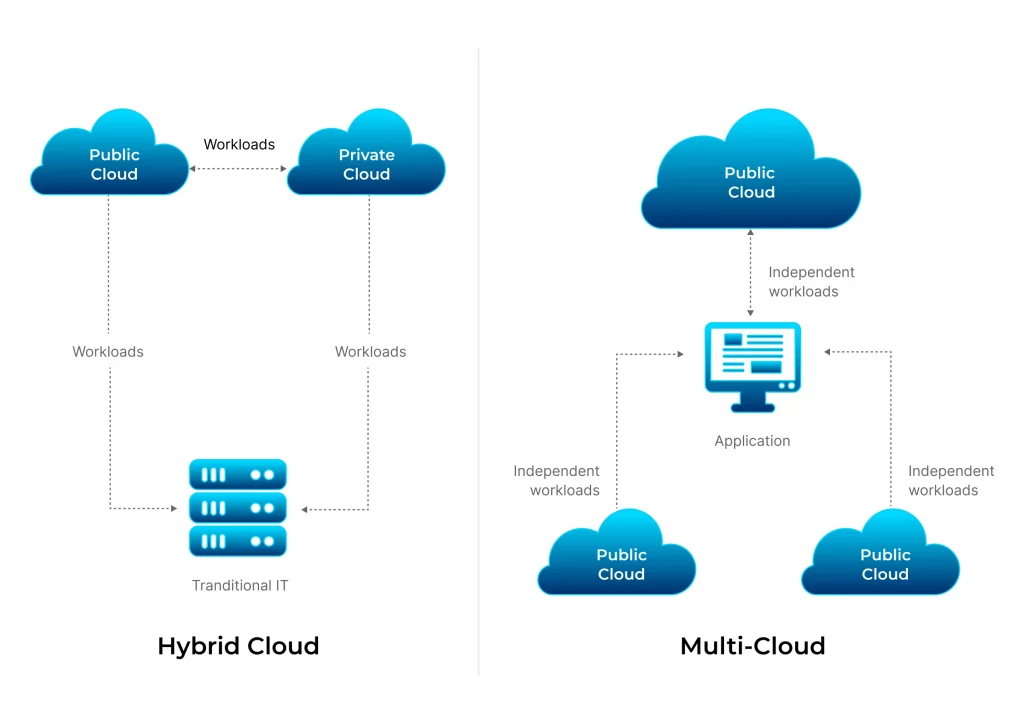Key Highlights
- Understand data gravity and its impact on cloud vendor lock-in.
- Learn strategies to maintain flexibility and avoid being tied to a single provider.
- Explore the benefits of open standards, data portability, and modular design.
- Discover tools and technologies that can mitigate the challenges of data gravity.
- Embrace a future-proof cloud strategy by leveraging multi-cloud and hybrid cloud environments.
Introduction
In today’s online world, cloud computing gives companies great flexibility and the ability to grow easily. But there is a risk of vendor lock-in. This is when businesses depend too much on one cloud provider. A factor called data gravity makes this issue more challenging, especially concerning data security. Data gravity means that data draws in apps and services. This blog post looks at helpful methods that companies can use to deal with data gravity. It also offers ways to break free from vendor lock-in.
Strategies to Escape Vendor Lock-In: Mastering Data Gravity in the Cloud
Data gravity is an important force in the cloud. It affects choices we make and can limit our options. It’s important to think carefully about adopting the best solution for cloud solutions. Rather than letting data gravity control your choices, you should let it help you. By using these strategies, you can enjoy the benefits of the cloud while keeping your freedom.
When dealing with data gravity in a multi-cloud or hybrid cloud setting, you need to make smart architectural choices. Also, being committed to open standards is vital. Keep your focus on having control and flexibility with your data. Here are some helpful steps you can take:
1. Assess and Understand Your Current Cloud Architecture
Before you make any decisions, take a good look at your current cloud environment and perform due diligence. Write down all application components, where your data is stored, and how they depend on your service provider. This will help you see how your organization might be held back by vendor lock and show you what needs attention. Find out which applications and data are most affected by data gravity in your current setup. Understanding this will help you create a plan that fits your needs.
When you have a clear view of your cloud situation, you can spot any bottlenecks, dependencies, and risks linked to data gravity. With this information, you can make smart choices about migrating, replicating, or separating certain workloads to improve your flexibility.
2. Advocate for Open Standards and Interoperability
Prioritizing open standards and open source in your cloud deployments is very important. When you choose cloud services that follow open standards, they can work with different vendors. This helps to ensure your data isn’t trapped in special formats. It also makes it easier and cheaper to switch providers if you need to in the future.
Supporting open-source projects encourages teamwork and innovation. It also gives you access to more talent and resources. By getting involved with the open-source community, you can help create new tools and best practices that help everyone in the cloud world.
3. Prioritize Data Portability in Your Cloud Strategy
Data portability should be a key part of your cloud plan. It is important to look at how easily you can move your data and applications between different systems. Choosing cloud providers that have strong data migration tools and support, and utilizing a standardized format for your data, can really help make this easier. Also, picking portable applications from the start can stop problems later during a cloud migration.
Moreover, adding data portability to your service-level agreements (SLAs) with cloud providers helps protect you. These agreements should explain the process for getting your data out and any fees linked to it. This way, you get more control and can feel more secure.
4. Implement Modular Design Principles
Adopting a modular design can greatly improve your flexibility by separating your cloud application components and splitting up apps into independent and reusable parts. This approach lessens their reliance on one vendor. Using standard APIs to connect the parts makes it easy to replace components or move them to a different setup without causing much trouble. This way, you protect yourself from being tied to one provider and keep your option to choose the best services and prices in the market.
5. Foster a Culture of Continuous Learning Among Your Team
Cloud technologies are always changing. It’s very important to build a culture of continuous learning in your team. You should encourage your IT manager and team members to keep up with the latest cloud trends and services. Holding regular training and workshops will help your team gain the knowledge they need to make smart choices and look for possible vendor lock risks early.
This awareness helps your team foresee problems and find other solutions before they get too big to handle. By promoting curiosity and trying new things, you can turn possible risks into chances for creativity and growth.

6. Leverage Multi-Cloud and Hybrid Cloud Environments
One good way to avoid vendor lock-in is to spread out your resources. You can use a multi-cloud strategy by working with different cloud providers. Another option is a hybrid cloud approach. This means you can mix private and public cloud environments which gives you more flexibility and control.
For example, you could keep sensitive data in a private cloud to ensure better security and meet regulatory compliance needs. At the same time, you can use a public cloud for other tasks because it is often cheaper and can grow as needed. This approach lowers the issues that come from data gravity with each provider. It can also help you have more power during contract talks.
7. Develop a Strong Exit Strategy Before Entering Any Agreement
Before choosing any cloud service, think about your long-term options. Make sure to ask for a clear exit strategy in your initial service agreement. Write down how you can get your data back, the time it will take, and any costs you might have when leaving the cloud vendor lock. This way, you will keep some power and flexibility, even if your needs change later.
Having a clear exit strategy is important. It protects you if you face any vendor problems, like poor performance or security issues. It also helps you grab new chances or innovations in the fast-changing cloud world.
Overcoming Data Gravity Challenges
Addressing data gravity is very important in today’s world where we rely so much on data. By knowing what data gravity means, finding possible problems, and using smart strategies, businesses can change what feels like a limitation into a chance to be more agile and gain a competitive edge. By following these suggestions, your organization can ease the issues caused by data gravity. This will help you make better choices that focus on being flexible and achieving success in the cloud for many years to come.
1. Identifying Key Data Gravity Centers
The first step to address data gravity is to find where it is strongest in your cloud infrastructure. You need to spot your biggest data stores, like data lakes, and see how applications and services depend on these data sources. By looking at how data moves and interacts in your cloud setup, you can find key areas where major changes or moves might cause problems or slowdowns.
Mapping these dependencies helps organizations understand what could happen if they move, copy, or change data and applications. This way, they can make better choices and reduce risks. Taking these steps ensures a smoother transition and cuts down the chance of unexpected issues during cloud migrations or changes in structure. According to a study, data gravity is expected to grow by 547% globally between 2020 and 2024.
2. Strategies for Data Mobilization and Access Across Clouds
Once we find key data centers, we need to make plans for easy data movement and access across different cloud platforms. Using strong data integration and replication tools helps organizations keep their data copies the same across many cloud service providers or regions. This method makes data more available and improves recovery during disasters. It also helps organizations place their data for better performance and lower costs.
Using data virtualization technology can help us see all data spread across different public cloud spaces or hybrid clouds. This technology hides the complex details and lets applications access data without needing to migrate it physically. A survey found that 84% of enterprises have a multi-cloud strategy, highlighting the importance of data mobilization across clouds.
3. Tools and Technologies to Mitigate Data Gravity Impact
Several tools and technologies can help mitigate the impact of data gravity in cloud computing environments. Here’s a breakdown:
|
Tool/Technology |
Description |
Benefits |
|
Data Fabric |
Enables unified data access and management across multiple data sources and locations. |
Improved data mobility, reduced latency, simplified data management. |
|
Edge Computing |
Brings computation and data processing closer to data sources. |
Reduced data movement, lower latency, improved real-time application performance. |
|
Containerization & Kubernetes |
Packages applications and dependencies into portable containers. |
Enhanced application portability, simplified deployment, improved scalability. |
|
Data Virtualization |
Creates a logical view of data from multiple sources without physical data movement. |
Reduced data movement, faster access to insights, simplified data governance. |
Utilizing these tools and techniques can help minimize the impact of data gravity on your cloud operations. Research indicates that by 2025, 75% of enterprise-generated data will be created and processed outside a traditional centralized data center or cloud, further emphasizing the need for these technologies.

Building a Future-Proof Cloud Infrastructure
Building a strong cloud infrastructure means focusing on being flexible, scalable, and adaptable in enterprise applications. Technology changes quickly. This means organizations must stay quick and ready to change their cloud plans as new trends and business needs come up. By using cloud-native technology, automation, and agile methods, you can build a solid base for new ideas and growth in our changing digital world.
1. Embracing Agile and Scalable Architectural Practices
Implementing agile and scalable building methods is important for creating a strong cloud infrastructure. Using a microservices approach means breaking applications into small, separate services. This helps with flexibility and makes development faster. It also allows you to easily scale parts of your system, so it can handle changes in demand.
Also, using infrastructure-as-code (IaC) practices helps keep your infrastructure consistent and easy to manage. This reduces the chance of mistakes and makes deployments smoother. By automating these steps, businesses can move faster to market, work better, and quickly adapt to what the market needs.
2. Investing in Cloud-Native Technologies
Cloud-native technologies are made for cloud settings. They offer many benefits that help keep your systems up-to-date. For example, serverless computing allows code to run on demand. This means you don’t have to worry about managing servers. It makes things simpler and can cut costs a lot. Managed services also help by hiding the complications of the infrastructure. This lets your team focus on adding value to the business. If organizations invest in these technologies, they can make cloud operations smoother, use resources better, and save a lot of money.
Also, cloud-native technologies encourage new ideas. They give developers a place to try things and quickly improve their work. A study found that by 2025, over 95% of new digital workloads are expected to be deployed on cloud-native platforms, highlighting the growing importance of these technologies.
3. The Role of Automation in Enhancing Cloud Flexibility
Automation is very important for making cloud services more flexible within IT infrastructure. By automating regular tasks like setting up resources, launching applications, and checking performance, companies can give their IT teams more time to work on important projects. Tools that allow for infrastructure as code help define and manage cloud resources easily. This makes sure things are consistent and can grow easily. It also reduces mistakes and speeds up deployments. This leads to better efficiency and less chance of making errors.
Also, automation helps developers access services on their own. This cuts down the need to rely on a central IT department and lets teams work more freely and efficiently. Research indicates that by 2025, 75% of enterprise-generated data will be created and processed outside a traditional centralized data center or cloud, emphasizing the need for flexible and automated cloud infrastructure.
Conclusion
In conclusion, dealing with data gravity in the cloud needs some careful planning and a forward-looking mindset. Start by checking your cloud setup. Support open standards and focus on data portability. Use modular design ideas and encourage ongoing learning. Make the most of multi-cloud environments, and have a solid exit plan to avoid vendor lock-in and keep your cloud infrastructure ready for the future. By knowing and tackling the challenges of data gravity, you can move data easily between clouds. Using agile methods, investing in cloud-native technologies, and applying automation are important steps toward a strong and adaptable cloud infrastructure. Stay active and flexible to achieve lasting success in the changing cloud world.

